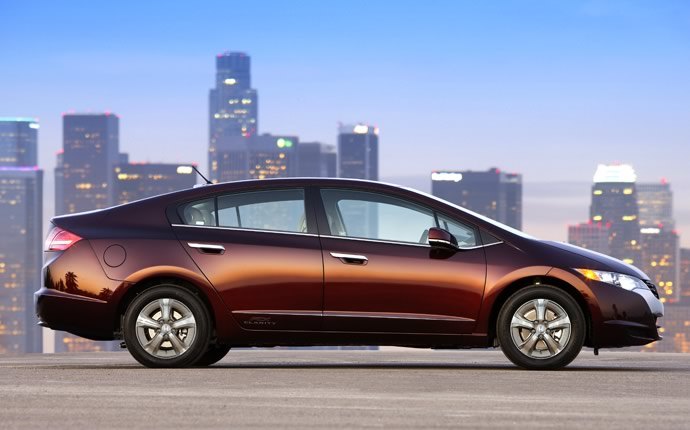Never Say Never: Hydrogen, Diesel En Vogue Again
Remember this piece from the Honda Summer 2008 Hydrogen Collection? It was supposed to point the way to future of green fuel technology before the Tesla brought plug-in sex appeal down the ramp with their Roadster and, later on, the S, as well as the trend of compliance EVs from Chevrolet, Volkswagen and Kia.
But with sales of plug-in hybrids advancing far slower than originally expected regulators are taking another look at alternative ZEV powertrains.
Back in 2009, U.S. President Barack Obama set a goal for 1 million EVs on the road by 2015, going so far as to place a $5 billion bet on Tesla and Fisker among other automakers. Since then, only 95,000 units have managed to leave the showroom for the open road, with sales of over 500,000 predicted for 2015 by West Bloomfield, Mich.-based Baum & Associates analyst Alan Baum. With the current administration downplaying their role in the EV market, President Obama is awarding $4 million to aid in the development of fuel cell technology and storage for hydrogen-powered vehicles.
Leading the charge toward the hydrogen future is California. Aside from passing a measure to provide 100 hydrogen fueling stations as part of their clean technology vision, the state’s legislature has fine-tuned the Zero-Emission Credit formula to better benefit hydrogen vehicle producers — such as Honda and General Motors, who announced a partnership to develop their respective technologies back in July — while drawing down power from Tesla to as much as 40 percent by 2015 for each S sold.
Back in D.C., Audi is putting the pressure on the Environmental Protection Agency to change their mileage formula for the showroom window sticker, and to level the playing field in taxation between diesel and gasoline. The reasoning, according to Audi of American president Scott Keogh, is that the current formula favors gasoline power on the assumption that most driving is done in the city; diesel it at its most efficient on the highway, and is one-third more efficient than gasoline in otherwise equal conveyances according to the U.S. Department of Energy. The diesels used today are cleaner as a result of the advent of ultra-low sulfur fuel and tailpipe exhaust treatment.
More by TTAC Staff
Latest Car Reviews
Read moreLatest Product Reviews
Read moreRecent Comments
- TheMrFreeze So basically no manual transmissions in US cars after 2029.I just raised one finger in the general direction of NHTSB's main office. Guess which finger it is!
- TheMrFreeze Wife drives a Fiat 500 Turbo 5-speed (135hp vs. 160 in the Abarth), it's a lot of fun to drive and hasn't given us any headaches. Maintenance on it is not as bad as you'd think for such a cramped engine compartment...Fiat did put some thought into it in that regard. Back seat is...cramped...but the front is surprisingly roomy for what it is.I honestly wouldn't mind having one myself, but yeah, gotta have a manual trans.
- Bkojote Tesla's in a death spiral right now. The closest analog would be Motorola circa 2007.The formula is the exact same. -Vocal CEO who came in and took credit for the foundation their predecessor while cutting said efforts behind successful projects.-A heavy reliance on price/margin cuts and heavy subsidies to keep existing stock moving. The RAZR became a $99 phone after starting out as a $399 phone, the same way a Model 3 is now a $25k car.-Increasing focus on BS projects over shipping something working and functional to distract shareholders from the failures of current products. Replace "iTunes Phone" (remember that?) with "Cybertruck" and when that's a dud focus on "Java-Linux" the same way they're now focusing "Robotaxis".-Increasingly cut away investment in quality-of-ownership things. Like Motorola, Tesla's cut cut cut away their development, engineering, and support teams. If you ever had the misfortune of using a Motorola Q you're familiar with just how miserable Tesla Autopilot is these days.-Ship less and less completed products as a preview of something new. Time and time again at CES/Trade Shows Motorola was showing half-working 'concept' devices. The Cybertruck was announced 5 years ago yet functionally is missing most of its features- and the ones it has don't work. And I mean basic stuff- the AWD logic is embarrassingly primitive. A lot of Tesla hyperbole focuses on either he's a 4D-chess playing genius visionary or all of Tesla's being propped up by gov't mandates. But the reality is this company hasn't delivered any meaningful product evolution in the better half of this past decade.
- Pig_Iron Stellantis is looking for excuses to close plants. Shawn Fain just gave them one. 🐹
- SCE to AUX Unresolved safety issues are a good reason to strike.


































Comments
Join the conversation
Every time I see Semi-trucks barreling about the interstates belching tones of burned diesel byproducts into the atmosphere, I wonder to myself why such a fuss is made about a few modern super efficient clean diesel cars with ever harsher emissions laws.
Thought I'd comment on my experience with a 2013 Cayenne diesel, my first "diesel experience". Just turned 14k miles. Overall, the vehicle is remarkable for it's thrust and with no special attention to economy the computer shows an average of 30mpg and change. I can now understand the appeal of these things in Europe, as the torque provides all the cut and thrust you really need and the economy is amazing considering the size of the vehicle. I read in a Porsche magazine (Panorama?) that 30% of Cayenne sales are diesel, far more than their expectation. The only con I have experienced is a less than exciting exhaust note - a small price to pay for such an excellent daily driver. For excitement, I would choose the GTS version, but for a frugal all rounder the diesel is the way to go.